August 2026 lunar eclipse
Astronomical event From Wikipedia, the free encyclopedia
A partial lunar eclipse will occur at the Moon’s ascending node of orbit on Friday, August 28, 2026,[1] with an umbral magnitude of 0.9319. A lunar eclipse occurs when the Moon moves into the Earth's shadow, causing the Moon to be darkened. A partial lunar eclipse occurs when one part of the Moon is in the Earth's umbra, while the other part is in the Earth's penumbra. Unlike a solar eclipse, which can only be viewed from a relatively small area of the world, a lunar eclipse may be viewed from anywhere on the night side of Earth. Occurring about 6 days after perigee (on August 22, 2026, at 4:20 UTC), the Moon's apparent diameter will be larger.[2]
| Partial eclipse | |||||||||||||
 The Moon's hourly motion shown right to left | |||||||||||||
| Date | August 28, 2026 | ||||||||||||
|---|---|---|---|---|---|---|---|---|---|---|---|---|---|
| Gamma | −0.4694 | ||||||||||||
| Magnitude | 0.9319 | ||||||||||||
| Saros cycle | 138 (30 of 83) | ||||||||||||
| Partiality | 198 minutes, 7 seconds | ||||||||||||
| Penumbral | 337 minutes, 46 seconds | ||||||||||||
| |||||||||||||
This lunar eclipse will be the last of an almost tetrad, with the others being on March 14, 2025 (total); September 8, 2025 (total); and March 3, 2026 (total).
Visibility
The eclipse will be completely visible over North and South America, seen rising over the central Pacific Ocean and setting over Africa, Europe, and the Middle East.[3]
  |
Eclipse details
Shown below is a table displaying details about this particular eclipse. It describes various parameters pertaining to this eclipse.[4]
| Parameter | Value |
|---|---|
| Penumbral Magnitude | 1.96645 |
| Umbral Magnitude | 0.93187 |
| Gamma | 0.49644 |
| Sun Right Ascension | 10h26m57.9s |
| Sun Declination | +09°42'52.7" |
| Sun Semi-Diameter | 15'50.0" |
| Sun Equatorial Horizontal Parallax | 08.7" |
| Moon Right Ascension | 22h26m06.3s |
| Moon Declination | -09°18'03.6" |
| Moon Semi-Diameter | 15'18.2" |
| Moon Equatorial Horizontal Parallax | 0°56'09.9" |
| ΔT | 72.3 s |
Eclipse season
This eclipse is part of an eclipse season, a period, roughly every six months, when eclipses occur. Only two (or occasionally three) eclipse seasons occur each year, and each season lasts about 35 days and repeats just short of six months (173 days) later; thus two full eclipse seasons always occur each year. Either two or three eclipses happen each eclipse season. In the sequence below, each eclipse is separated by a fortnight.
| August 12 Descending node (new moon) | August 28 Ascending node (full moon) |
|---|---|
 |  |
| Total solar eclipse Solar Saros 126 | Partial lunar eclipse Lunar Saros 138 |
Related eclipses
Summarize
Perspective
Eclipses in 2026
- An annular solar eclipse on February 17.
- A total lunar eclipse on March 3.
- A total solar eclipse on August 12.
- A partial lunar eclipse on August 28.
Metonic
- Preceded by: Lunar eclipse of November 8, 2022
- Followed by: Lunar eclipse of June 15, 2030
Tzolkinex
- Preceded by: Lunar eclipse of July 16, 2019
- Followed by: Lunar eclipse of October 8, 2033
Half-Saros
- Preceded by: Solar eclipse of August 21, 2017
- Followed by: Solar eclipse of September 2, 2035
Tritos
- Preceded by: Lunar eclipse of September 28, 2015
- Followed by: Lunar eclipse of July 27, 2037
Lunar Saros 138
- Preceded by: Lunar eclipse of August 16, 2008
- Followed by: Lunar eclipse of September 7, 2044
Inex
- Preceded by: Lunar eclipse of September 16, 1997
- Followed by: Lunar eclipse of August 7, 2055
Triad
- Preceded by: Lunar eclipse of October 28, 1939
- Followed by: Lunar eclipse of June 29, 2113
Lunar eclipses of 2024–2027
This eclipse is a member of a semester series. An eclipse in a semester series of lunar eclipses repeats approximately every 177 days and 4 hours (a semester) at alternating nodes of the Moon's orbit.[5]
The penumbral lunar eclipse on July 18, 2027 occurs in the next lunar year eclipse set.
| Lunar eclipse series sets from 2024 to 2027 | ||||||||
|---|---|---|---|---|---|---|---|---|
| Descending node | Ascending node | |||||||
| Saros | Date Viewing |
Type Chart |
Gamma | Saros | Date Viewing |
Type Chart |
Gamma | |
113 |
2024 Mar 25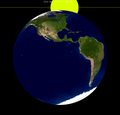 |
Penumbral |
1.0610 | 118 |
2024 Sep 18 |
Partial |
−0.9792 | |
123 |
2025 Mar 14 |
Total |
0.3485 | 128 | 2025 Sep 07 |
Total |
−0.2752 | |
| 133 | 2026 Mar 03 |
Total |
−0.3765 | 138 | 2026 Aug 28 |
Partial |
0.4964 | |
| 143 | 2027 Feb 20 |
Penumbral |
−1.0480 | 148 | 2027 Aug 17 |
Penumbral |
1.2797 | |
Metonic series
The Metonic cycle repeats nearly exactly every 19 years and represents a Saros cycle plus one lunar year. Because it occurs on the same calendar date, the Earth's shadow will be in nearly the same location relative to the background stars.
|
|
 |
 |
Saros 138
This eclipse is a part of Saros series 138, repeating every 18 years, 11 days, and containing 82 events. The series started with a penumbral lunar eclipse on October 15, 1521. It contains partial eclipses from June 24, 1918 through August 28, 2026; total eclipses from September 7, 2044 through June 8, 2495; and a second set of partial eclipses from June 19, 2513 through August 13, 2603. The series ends at member 82 as a penumbral eclipse on March 30, 2982.
The longest duration of totality will be produced by member 48 at 105 minutes, 24 seconds on March 24, 2369. All eclipses in this series occur at the Moon’s ascending node of orbit.[6]
| Greatest | First | |||
|---|---|---|---|---|
| The greatest eclipse of the series will occur on 2369 Mar 24, lasting 105 minutes, 24 seconds.[7] | Penumbral | Partial | Total | Central |
| 1521 Oct 15 |
1918 Jun 24 |
2044 Sep 07 |
2116 Oct 21 | |
| Last | ||||
| Central | Total | Partial | Penumbral | |
| 2441 May 06 |
2495 Jun 08 |
2603 Aug 13 |
2982 Mar 30 | |
Eclipses are tabulated in three columns; every third eclipse in the same column is one exeligmos apart, so they all cast shadows over approximately the same parts of the Earth.
| Series members 17–38 occur between 1801 and 2200: | |||||
|---|---|---|---|---|---|
| 17 | 18 | 19 | |||
| 1810 Apr 19 | 1828 Apr 29 | 1846 May 11 | |||
| 20 | 21 | 22 | |||
| 1864 May 21 | 1882 Jun 01 | 1900 Jun 13 | |||
| 23 | 24 | 25 | |||
| 1918 Jun 24 | 1936 Jul 04 | 1954 Jul 16 | |||
 |
 |
 |
 |
 |
 |
| 26 | 27 | 28 | |||
| 1972 Jul 26 | 1990 Aug 06 | 2008 Aug 16 | |||
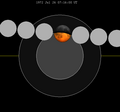 |
 |
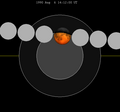 |
 |
 |
 |
| 29 | 30 | 31 | |||
| 2026 Aug 28 | 2044 Sep 07 | 2062 Sep 18 | |||
 |
 |
 |
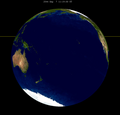 |
||
| 32 | 33 | 34 | |||
| 2080 Sep 29 | 2098 Oct 10 | 2116 Oct 21 | |||
 |
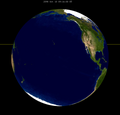 |
||||
| 35 | 36 | 37 | |||
| 2134 Nov 02 | 2152 Nov 12 | 2170 Nov 23 | |||
| 38 | |||||
| 2188 Dec 04 | |||||
Tritos series
This eclipse is a part of a tritos cycle, repeating at alternating nodes every 135 synodic months (≈ 3986.63 days, or 11 years minus 1 month). Their appearance and longitude are irregular due to a lack of synchronization with the anomalistic month (period of perigee), but groupings of 3 tritos cycles (≈ 33 years minus 3 months) come close (≈ 434.044 anomalistic months), so eclipses are similar in these groupings.
| Series members between 1801 and 2200 | |||||||||
|---|---|---|---|---|---|---|---|---|---|
| 1808 May 10 (Saros 118) |
1819 Apr 10 (Saros 119) |
1830 Mar 09 (Saros 120) |
1841 Feb 06 (Saros 121) |
1852 Jan 07 (Saros 122) | |||||
| 1862 Dec 06 (Saros 123) |
1873 Nov 04 (Saros 124) |
1884 Oct 04 (Saros 125) |
1895 Sep 04 (Saros 126) |
1906 Aug 04 (Saros 127) | |||||
 |
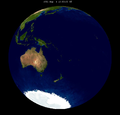 | ||||||||
| 1917 Jul 04 (Saros 128) |
1928 Jun 03 (Saros 129) |
1939 May 03 (Saros 130) |
1950 Apr 02 (Saros 131) |
1961 Mar 02 (Saros 132) | |||||
 |
 |
 |
 |
 |
 |
 |
 |
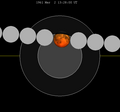 |
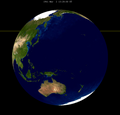 |
| 1972 Jan 30 (Saros 133) |
1982 Dec 30 (Saros 134) |
1993 Nov 29 (Saros 135) |
2004 Oct 28 (Saros 136) |
2015 Sep 28 (Saros 137) | |||||
 |
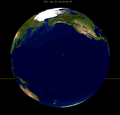 |
 |
 |
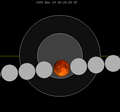 |
 |
 |
 |
 |
 |
| 2026 Aug 28 (Saros 138) |
2037 Jul 27 (Saros 139) |
2048 Jun 26 (Saros 140) |
2059 May 27 (Saros 141) |
2070 Apr 25 (Saros 142) | |||||
 |
 |
 |
 |
 |
 |
 |
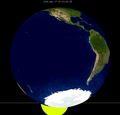 |
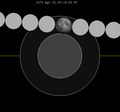 |
 |
| 2081 Mar 25 (Saros 143) |
2092 Feb 23 (Saros 144) |
2103 Jan 23 (Saros 145) |
2113 Dec 22 (Saros 146) |
2124 Nov 21 (Saros 147) | |||||
| 2135 Oct 22 (Saros 148) |
2146 Sep 20 (Saros 149) |
2157 Aug 20 (Saros 150) |
2168 Jul 20 (Saros 151) |
2179 Jun 19 (Saros 152) | |||||
| 2190 May 19 (Saros 153) | |||||||||
Inex series
This eclipse is a part of the long period inex cycle, repeating at alternating nodes, every 358 synodic months (≈ 10,571.95 days, or 29 years minus 20 days). Their appearance and longitude are irregular due to a lack of synchronization with the anomalistic month (period of perigee). However, groupings of 3 inex cycles (≈ 87 years minus 2 months) comes close (≈ 1,151.02 anomalistic months), so eclipses are similar in these groupings.
| Series members between 1801 and 2200 | |||||
|---|---|---|---|---|---|
| 1824 Jan 16 (Saros 131) |
1852 Dec 26 (Saros 132) |
1881 Dec 05 (Saros 133) | |||
| 1910 Nov 17 (Saros 134) |
1939 Oct 28 (Saros 135) |
1968 Oct 06 (Saros 136) | |||
 |
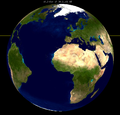 |
 |
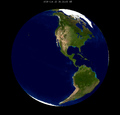 |
 |
 |
| 1997 Sep 16 (Saros 137) |
2026 Aug 28 (Saros 138) |
2055 Aug 07 (Saros 139) | |||
 |
 |
 |
 |
 |
 |
| 2084 Jul 17 (Saros 140) |
2113 Jun 29 (Saros 141) |
2142 Jun 08 (Saros 142) | |||
| 2171 May 19 (Saros 143) |
2200 Apr 30 (Saros 144) | ||||
Half-Saros cycle
A lunar eclipse will be preceded and followed by solar eclipses by 9 years and 5.5 days (a half saros).[8] This lunar eclipse is related to two total solar eclipses of Solar Saros 145.
See also
Notes
External links
Wikiwand - on
Seamless Wikipedia browsing. On steroids.


